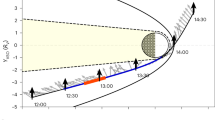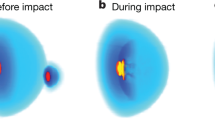Abstract
Several planetary missions have reported1,2,3,4 the presence of substantial numbers of energetic ions and electrons surrounding Jupiter; relativistic electrons are observable up to several astronomical units (au) from the planet. A population of energetic (>30 keV) neutral particles also has been reported5, but the instrumentation was not able to determine the mass or charge state of the particles, which were subsequently labelled6 energetic neutral atoms. Although images showing the presence of the trace element sodium were obtained7, the source and identity of the neutral atoms—and their overall significance relative to the loss of charged particles from Jupiter's magnetosphere—were unknown. Here we report the discovery by the Cassini spacecraft of a fast (>103 km s-1) and hot magnetospheric neutral wind extending more than 0.5 au from Jupiter, and the presence of energetic neutral atoms (both hot and cold) that have been accelerated by the electric field in the solar wind. We suggest that these atoms originate in volcanic gases from Io, undergo significant evolution through various electromagnetic interactions, escape Jupiter's magnetosphere and then populate the environment around the planet. Thus a ‘nebula’ is created that extends outwards over hundreds of jovian radii.
Similar content being viewed by others
Main
The detectors on the Cassini mission are specifically designed to detect and ‘image’ such energetic neutral atoms emanating from planetary magnetospheres. The magnetosphere imaging instrument (MIMI)8 uses an ion and neutral camera (INCA) sensor that rejects charged particles and can detect energetic neutral atoms over the velocity range ∼103 to ∼104 km s-1 using a time-of-flight technique, with crude separation into light (that is, H, He) and heavy (that is, O, S) components. A second MIMI sensor, the charge–energy–mass spectrometer (CHEMS) is capable of determining independently the charge state, mass, and energy of ions over the range of ∼3 to ∼220 keV per charge.
The presence of Jupiter in terms of energetic neutral atom fluxes became evident soon after the beginning of the Cassini Observatory phase on 1 October 2000, at a distance of ∼0.5 au from Jupiter. The intensity from the peak location in the 32 × 32 pixel image continued to grow, roughly as r-2, as the spacecraft approached the planet. By the closest approach on 30 December, the image had spread to several pixels. A sample of these images is shown in Fig. 1. There is some evidence of structure in the image, although a significant amount of spreading is due to the point spread function in the instrument (arising from scattering of atoms as they encounter the first foil in the detector)9. The intensity is highest at the equatorial plane and extends north and south, as well as in radial distance, roughly as expected from pre-encounter simulations10. The velocity distribution in each image pixel is constructed by pulse-height analysis. Although not shown here, it reveals two populations in the measured velocity range corresponding to low and high mass, presumed to be H and O, respectively. Our preliminary view is that Cassini's spectra are consistent with an ion population originating inside about 10 RJ, where one jovian radius RJ = 72,400 km.
Detailed measurements of ion composition are obtained by the CHEMS sensor. Figure 2 shows an energy spectrogram of He+ species for about a month before the first encounter of the jovian bow shock, on day 363. There is significant, low-level activity, above instrument background, throughout this period, interspersed with several intervals of more intense fluxes that are especially evident whenever the spacecraft -x axis was pointed in the general direction of the Sun. Such orientation enables one of three CHEMS sensors (telescope 2) to view the solar wind direction8, and thus become more sensitive to interplanetary pick-up ions11. A notable feature is the varying upper energy cutoff in the intensifications ranging from over 20 keV e-1 to ≤10 keV e-1; these cutoffs are directly related to the peak solar wind velocity in the vicinity of the spacecraft, and correspond to ∼500 km s-1 to ∼350 km s-1 for high and low cutoffs, respectively. In some cases (for example, on day 343) maximum energies extend much higher, suggesting additional acceleration (see below).
The Cassini spacecraft was in the interplanetary medium upstream of Jupiter until day 363, when it encountered Jupiter's bow shock for the first time. The red bars show periods when the spacecraft -x axis was pointed in the solar direction and the white spaces correspond to periods of telemetry interruptions.
Although He+ is of interstellar origin11 and is always present in the interplanetary medium, many ion species observed during this period are of jovian origin. This is shown in Fig. 3, which is a histogram of number of events versus mass per charge summed over all species observed during periods when the Cassini -x axis is pointing in the solar direction before the first bow shock crossing (days 338–353). In addition to H+, He+, and He2+, there are significant peaks at O+, S+, and SO2+ (or S2+). The relatively high energy range for this histogram (55–220 keV e-1) emphasizes the heavier pick-up ions of jovian origin, relative to the interstellar He+. The H+ and He++ ions at these energies are not pick-up ions but are instead accelerated by some other process. Statistical uncertainty does not allow identification of other species, although a peak near Ne+ and Na+ is suggested.
The results presented above highlight two previously unknown features of the cis-jovian environment, shown schematically in Fig. 4. The first is the presence of a continuous flow of fast energetic neutrals in the velocity range ∼103 to ∼104 km s-1, detectable to more than 0.5 au upstream from the planet. These neutrals probably extend to both lower and higher velocities, and to greater distances from Jupiter than ∼0.5 au, beyond the ability of the INCA sensor to measure in its present configuration. The region of energetic neutral atom emission is within 30 RJ of Jupiter (Fig. 1) and appears to be most intense in the vicinity of Io's plasma torus, as we expected.
The boundary of Jupiter's magnetosphere in a meridional cross-section is shown, as is the cross-section of the Io torus. Multicoloured dots are intended to show hot planetary fast neutrals expanding outward in all directions. Green dots represent the cold wind and originate from a lower energy wind of neutral atoms and molecules escaping Io's plasma torus following charge exchange and having a corotation speed of ∼75 km s-1, generally confined close to Jupiter's equatorial plane. A few neutrals, converted into pick-up ions, are shown gyrating in the general direction of the solar wind, outside the magnetosphere. The solar disk is included for scale.
Assuming spherical symmetry, we estimate the torus loss rate in the measured velocity range to be ∼1–2 × 1026 ions s-1, that is, a small fraction of the overall input rate into the torus of ∼1028 s-1 (ref. 12). Extrapolation to lower velocities can easily increase this rate to ∼1027 s-1, that is, to a value comparable to the expected loss rate through Jupiter's magnetospheric wind13.
The second new feature observed is, by and large, a consequence of the first, in that neutrals escaping Jupiter's magnetosphere, both hot and cold, would be subject to photoionization and thus pick-up by the solar wind electric field7,14, attaining a maximum pick-up energy corresponding to twice the solar wind velocity11. Furthermore, energetic ions may well escape the magnetosphere and travel upstream in the solar wind under favourable conditions, when the interplanetary magnetic field connects the spacecraft to Jupiter's bow shock3. Figure 2 shows examples of both processes. The cutoff energies for He+ are evidence of the former, while the high energy tails (for example, on days 339, 343 and 354) constitute potential evidence for the latter. Additional study is required to separate escaping energetic ions from those accelerated in interplanetary space. More to the point, the presence of O+, S+, and possibly SO2+ shows that some fraction of the fast and cold neutral winds from Jupiter becomes reionized and must have some influence in removing energy from the solar wind near Jupiter. Although our analysis of this data set has not progressed far enough to provide a definitive estimate, post-Voyager modelling12 suggests that this energy reduction could amount to several per cent. This ‘jovian nebula’ is a permanent element of the cis-jovian environment in our Solar System, invisible to distant telescopes for the majority species of O, S, SO2, and so on, but visible for the trace element Na (ref. 7).
References
Teegarden, B. J. et al. Interplantary MeV electrons of Jovian origin. J. Geophys. Res. 79, 3615–3622 (1974).
Zwickl, R. D. et al. Energetic particle events (≥30 keV) of Jovian origin observed by Voyager 1 and 2 in interplanetary space. J. Geophys. Res. 86, 8125–8140 (1981).
Krimigis, S. M., Zwickl, R. D. & Baker, D. N. Energetic ions upstream of Jupiter's bow shock. J. Geophys. Res. 90, 3947–3960 (1985).
Haggerty, D. & Armstrong, T. P. Observations of Jovian upstream events by Ulysses. J. Geophys. Res. 104, 4629–4642 (1999).
Kirsch, E., Krimigis, S. M., Kohl, J. W. & Keath, E. P. Upper limits for X-ray and energetic neutral particle emission from Jupiter: Voyager-1 results. Geophys. Res. Lett. 8, 169–172 (1981).
Roelof, E. C., Mitchell, D. G. & Williams, D. J. Energetic neutral atoms (E ∼50 keV) from the ring current: IMP 7/8 and ISEE-1. J. Geophys. Res. 90, 10991–11008 (1985).
Mendillo, M., Baumgardner, J. & Flynn, B. Imaging observations of Jupiter's sodium magneto-nebula during the Ulysses encounter. Science 257, 1510–1512 (1992).
Krimigis, S. M. et al. Magnetospheric imaging instrument (MIMI) on the Cassini mission to Saturn/Titan. Space Sci. Rev. (in the press).
Mitchell, D. G. et al. The imaging neutral camera (INCA) for the NASA Cassini mission to Saturn and Titan, and possibilities for the future. Proc SPIE Int. Symp. Opt. Sci. Eng. Instrum.—Mission to the Sun 2803, 154–161 (1996).
Mauk, B. H., Krimigis, S. M., Mitchell, D. G. & Roelof, E. C. Energetic neutral atom imaging of Jupiter's magnetosphere using the Cassini MIMI instrument. Adv. Space Res. 21(11), 1483–1486 (1998).
Gloeckler, G, Geiss, J. & Fisk, L. A. in The Heliosphere Near Solar Minimum (eds Balogh, A., Marsden, R. G. & Smith, E. J.) 287–326 (Praxis, Chichester, 2001).
Barbosa, D. D. & Eviatar, A. Planetary fast neutral emission and effects in the solar wind: A cometary exosphere analog. Astrophys. J. 310, 927–936 (1986).
Krimigis, S. M. et al. Characteristics of hot plasma in the Jovian magnetosphere: Results from the Voyager spacecraft. J. Geophys. Res. 86, 8227–8257 (1981).
Luhmann, J. G. Oxygen in the heliosphere. J. Geophys. Res. 99, 13285–13305 (1994).
Acknowledgements
We thank many colleagues who contributed to the hardware effort for MIMI at the Applied Physics Laboratory of Johns Hopkins, the Department of Physics at the University of Maryland, the Max-Planck-Institut für Aeronomie (MPAe) and the Centre d'Etude Spatiale des Rayonnements (CESR) in Toulouse. We also thank S. J. Jaskulek, J. Hayes, M. Kusterer and B. Tossman for their contributions throughout the programme. This work was supported by NASA under contract with the Johns Hopkins University; by subcontracts at the University of Maryland, Kansas, and Arizona; and by Deutsches Zentrum für Luft und Raumfahrt (DLR) at MPAe and Centre National d'Etudes Spatiales (CNES) at CESR.
Author information
Authors and Affiliations
Corresponding author
Rights and permissions
About this article
Cite this article
Krimigis, S., Mitchell, D., Hamilton, D. et al. A nebula of gases from Io surrounding Jupiter. Nature 415, 994–996 (2002). https://doi.org/10.1038/415994a
Received:
Accepted:
Issue Date:
DOI: https://doi.org/10.1038/415994a
This article is cited by
-
Towards a Global Unified Model of Europa’s Tenuous Atmosphere
Space Science Reviews (2018)
-
Exospheres and Atmospheric Escape
Space Science Reviews (2008)
-
Magnetosphere Imaging Instrument (MIMI) on the Cassini Mission to Saturn/Titan
Space Science Reviews (2004)
-
Energetic neutral atoms from a trans-Europa gas torus at Jupiter
Nature (2003)
Comments
By submitting a comment you agree to abide by our Terms and Community Guidelines. If you find something abusive or that does not comply with our terms or guidelines please flag it as inappropriate.







